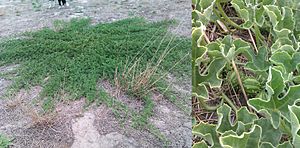Paddy melon facts for kids
Quick facts for kids Paddy melon |
|
|---|---|
 |
|
| Scientific classification | |
| Genus: |
Cucumis
|
| Species: |
myriocarpus
|
The paddy melon (scientific name: Cucumis myriocarpus) is a wild plant that grows close to the ground or climbs. It's an annual herb, meaning it lives for one growing season. This plant is originally from parts of Africa. It's known by other names too, like gooseberry cucumber or prickly paddy melon.
You can spot paddy melons by their small, round fruits. These fruits are usually yellow-green or have green stripes. They also have soft spines. The plant has small yellow flowers and light green leaves that are deeply lobed, almost like fingers. Paddy melons like to grow in disturbed soil or open, bare areas, especially when there's plenty of moisture in the summer.
Contents
What is a Paddy Melon?
Appearance and Growth
The paddy melon plant is a type of vine. It can spread out along the ground or climb over other plants. Its scientific name, Cucumis myriocarpus, tells us it's related to cucumbers.
The fruit of the paddy melon is quite small. It's usually smaller than a golf ball. When it's young, it's green. As it gets older, it turns yellow. These fruits are often hidden under the plant's leaves.
Where Do Paddy Melons Grow?
Paddy melons are native to tropical and southern Africa. However, they have spread to other parts of the world. They are now found in places like Australia and California. They also grow naturally in Spain.
Why Paddy Melons Can Be Harmful
Toxic Parts of the Plant
It's important to know that the paddy melon plant is poisonous. Both its fruit and its leaves contain harmful substances called cucurbitacin. These substances make the plant toxic.
Eating parts of the plant can be dangerous. It is toxic to humans. It can also harm animals like horses, sheep, cattle, and pigs. There have been cases where animals have gotten sick or even died from eating it.
Historical Uses and Dangers
In the past, some people used the paddy melon as a medicine. It was used to make people throw up. This was a way to get rid of harmful things from the body. However, there are records of people getting poisoned from using it. Because it's so toxic, it's not safe to use.
Paddy Melons as a Problem Plant
What is a Noxious Weed?
In some places, the paddy melon is considered a noxious weed. This means it's a plant that causes harm. It can harm the environment, agriculture, or public health. Governments often try to control or get rid of noxious weeds.
Paddy Melons in Australia
In Australia, the paddy melon is a big problem. It's an invasive species. This means it's a plant that was brought to Australia from somewhere else. It then spread quickly and caused damage.
Paddy melons cause a lot of trouble for farmers. They can take over farmland. This means farmers have to spend money and effort to get rid of them. The plant can also harm livestock if animals eat it.
Confusing Melons
In Australia, the paddy melon is often confused with another wild melon. This other melon is called Citrullus lanatus. It's also known as the Afghan melon or camel melon. This plant is a wild relative of the watermelon.
- Cucumis myriocarpus (paddy melon) has many small, green fruits. They turn yellow when ripe.
- Citrullus lanatus (Afghan melon) has larger fruits. These are the bigger green and yellow melons often seen on roadsides.
Many people in Australia mistakenly call the larger Citrullus lanatus fruit a "paddy melon." Children in rural Australia sometimes use the larger fruits for fun. They might throw them or squeeze them to shoot seeds.
Managing Wild Melons
How to Tell Them Apart
It can be tricky to tell the paddy melon and Afghan melon apart. They look quite similar. The leaves of the Afghan melon might be a bit more varied in color. The easiest way to tell them apart is by the size of their fruit. Paddy melon fruits are much smaller.
Control Methods
Even though they are different, both types of wild melons are managed in similar ways.
- Small areas: If there are only a few plants, they can be removed by hand.
- Early growth: Tilling the soil when the plants are young can also be effective.
- Large areas: For big areas, a method called "spray-graze" is sometimes used. This involves spraying the plants with a small amount of herbicide. This makes the plants more appealing to animals. Then, animals are allowed to graze heavily in the area a few days later. Other food is provided to make sure the animals don't get sick from the melons.
Why Animals Don't Always Eat Them
Both wild melon species have a strong, unpleasant smell. This smell makes them less tasty to animals. So, animals usually only eat them if there isn't much other food available. This is why poisoning tends to happen when food is scarce.
Images for kids


